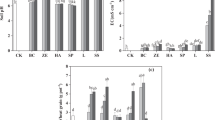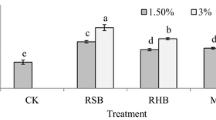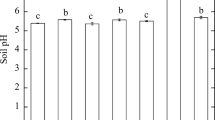Abstract
In this paper biochar (BC) and traditional soil amendments, including press mud (PrM), farm manure (FM), compost (Cmp), poultry manure (PM) and sewage sludge (SS), were evaluated as carbon sources (20 g kg−1 organic carbon) to assess their ability to store soil organic carbon as well as their effects on the bioavailability, transfer and immobilization of Cd in contaminated soil. Wheat (Triticum aestivum L.) was grown on unamended and amended soil (at 2 % organic carbon basis) in a greenhouse experiment and the soil characteristics, AB-DTPA extractable Cd and metal uptake were determined. The influence of the applied organic carbon amendments on the soil properties and accumulation of Cd was evaluated and compared to unamended soil. All of the amendments increased the soil OC significantly with the highest value (1.2 %) with BC followed by PrM (0.98 %) and Cmp (0.86 %). The maximum decrease in the AB-DTPA extractable Cd (43.82 %) was recorded with the BC amendment followed by Cmp (18.16 %), while FM and PrM amendments increased the Cd availability up to 19.92 and 4.45 %, respectively. The uptake of Cd by Triticum aestivum L. was increased with all of the amendments except for BC and Cmp, which showed significant decreases, and the maximum transfer factor was found in SS followed by PrM, PM and FM. The soil organic carbon (OC), cation exchange capacity (CEC) and pH were negatively correlated with the AB-DTPA extractable Cd in post-experiment soil. The results obtained from this experiment suggest that organic carbon from biochar (BC) can be used to increase the soil OC stock, and it is also effective for the in situ immobilization/remediation of Cd, thus improving the physico-chemical properties of soil and leading to increased plant growth.






Similar content being viewed by others
References
Abbott DE, Essington ME, Mullen MD, Ammons JT (2001) Fly ash and lime-stabilized biosolid mixtures in mine spoil reclamation: simulated weathering. J Environ Qual 30:608–616. doi:10.2134/jeq2001.302608x
Arnesen KM, Singh BR (1998) Plant uptake and DTPA-extractability of Cd, Cu, Ni and Zn in a Norwegian alum shale soil as affected by previous addition of dairy and pig manures and peat. Can J Soil Sci 78:531–539. doi:10.4141/S97-093
Bernard A (2008) Cadmium & its adverse effects on human health. Indian J Med Res 128:557–564
Brown SL, Chaney RL, Angle JS, Ryan JA (1998) The phytoavailability of cadmium to lettuce in long-term biosolids-amended soils. J Environ Qual 27:1071. doi:10.2134/jeq1998.00472425002700050012x
Bulluck LR, Brosius M, Evanylo GK, Ristaino JB (2002) Organic and synthetic fertility amendments influence soil microbial, physical and chemical properties on organic and conventional farms. Appl Soil Ecol 19:147–160
Carbonell G, de Imperial RM, Torrijos M et al (2011) Effects of municipal solid waste compost and mineral fertilizer amendments on soil properties and heavy metals distribution in maize plants (Zea mays L.). Chemosphere 85:1614–1623
Chamon AS, Gerzabek MH, Mondol MN et al (2005) Influence of soil amendments on heavy metal accumulation in crops on polluted soils of Bangladesh. Commun Soil Sci Plant Anal 36:907–924. doi:10.1081/CSS-200049472
Chiang P, Wang MK, Chiu CY, Chou S (2006) Effects of cadmium amendments on low-molecular-weight organic acid exudates in rhizosphere soils of tobacco and sunflower. Environ Toxicol 21:479–488. doi:10.1002/tox.20210
Das P, Samantaray S, Rout GR (1997) Studies on cadmium toxicity in plants: a review. Environ Pollut 98:29–36. doi:10.1016/S0269-7491(97)00110-3
Edward BB (2000) The economic linkages between rural poverty and land degradation: some evidence from Africa. Agric Ecosyst Environ 82:355–370. doi:10.1016/S0167-8809(00)00237-1
Ensink JHJ, Van Der Hoek W (2009) Implementation of the WHO guidelines for the safe use of wastewater in Pakistan: balancing risks and benefits. J Water Health 7:464–468
Everhart JL, McNear D, Peltier E et al (2006) Assessing nickel bioavailability in smelter-contaminated soils. Sci Total Environ 367:732–744. doi:10.1016/j.scitotenv.2005.12.029
FAO (1998) World reference base for soil resources, soil science. FAO, Rome. doi:10.1081/E-ESS-120042785
Geoffroy-Siraudin C, Perrard MH, Ghalamoun-Slaimi R et al (2012) Ex-vivo assessment of chronic toxicity of low levels of cadmium on testicular meiotic cells. Toxicol Appl Pharmacol 262:238–246
Ghosh S, Wilson B, Ghoshal S et al (2012) Organic amendments influence soil quality and carbon sequestration in the Indo-Gangetic plains of India. Agric Ecosyst Environ 156:134–141. doi:10.1016/j.agee.2012.05.009
Hu J, Wu F, Wu S et al (2014) Biochar and Glomus caledonium influence Cd accumulation of upland kangkong (Ipomoea aquatica Forsk.) intercropped with Alfred stonecrop (Sedum alfredii Hance). Sci Rep 4:4671
Ingram JSI, Gregory PJ, Izac AM (2008) The role of agronomic research in climate change and food security policy. Agric Ecosyst Environ 126:4–12. doi:10.1016/j.agee.2008.01.009
Jackson ML (1962) Soil chemical analysis. Constable and Co., Ltd., London
Jin S, Zhou J (2011) Adoption of food safety and quality standards by China’s agricultural cooperatives. Food Control 22:204–208
Kabata-Pendias A, Pendias H (2001) Trace elements in soils and plants. CRC Press, New York
Karaca A (2004) Effect of organic wastes on the extractability of cadmium, copper, nickel, and zinc in soil. Geoderma 122:297–303. doi:10.1016/j.geoderma.2004.01.016
Kirkham MB (2006) Cadmium in plants on polluted soils: effects of soil factors, hyperaccumulation, and amendments. Geoderma 137:19–32
Lehmann J (2007) Bio-energy in the black. Front Ecol Environ 5:381–387. doi:10.1890/1540-9295(2007)5[381:BITB]2.0.CO;2
Lombi E, Zhao FJ, Zhang G et al (2002) In situ fixation of metals in soils using bauxite residue: chemical assessment. Environ Pollut 118:435–443. doi:10.1016/S0269-7491(01)00294-9
Lu Q, Liang F, Bia X, Duffya R, Zhaoa Z (2011) Effects of urbanization and industrialization on agricultural land use in Shandong Peninsula of China. Ecol Ind 11:1710–1714
Mapanda F, Mangwayana EN, Nyamangara J, Giller KE (2005) The effect of long-term irrigation using wastewater on heavy metal contents of soils under vegetables in Harare, Zimbabwe. Agric Ecosyst Environ 107:151–165. doi:10.1016/j.agee.2004.11.005
McBride MB (2002) Cadmium uptake by crops estimated from soil total Cd and pH. Soil Sci 167:62–67
Mench M, Didier V, Loffler M, Gomez A, Masson P (1994) A mimicked in situ remediation study of metal contaminated soils with emphasis on cadmium and lead. J Environ Qual 23:58–63
Misra V, Chaturvedi PK (2007) Plant uptake/bioavailability of heavy metals from the contaminated soil after treatment with humus soil and hydroxyapatite. Environ Monit Assess 133:169–176. doi:10.1007/s10661-006-9570-5
Murtaza G, Ghafoor A, Qadir M et al (2010) Disposal and use of sewage on agricultural lands in Pakistan: a review. Pedosphere 20:23–34
Muyanga M, Jayne TS (2014) Effects of rising rural population density on smallholder agriculture in Kenya. Food Policy 48:98–113. doi:10.1016/j.foodpol.2014.03.001
Park JH, Lamb D, Paneerselvam P et al (2011) Role of organic amendments on enhanced bioremediation of heavy metal(loid) contaminated soils. J Hazard Mater 185:549–574. doi:10.1016/j.jhazmat.2010.09.082
Roane TM, Josephson KL, Pepper IL (2001) Dual-bioaugmentation strategy to enhance remediation of cocontaminated soil. Appl Environ Microbiol 67:3208–3215. doi:10.1128/AEM.67.7.3208-3215.2001
Roth E, Mancier V, Fabre B (2012) Adsorption of cadmium on different granulometric soil fractions: influence of organic matter and temperature. Geoderma 189–190:133–143. doi:10.1016/j.geoderma.2012.04.010
Sandalio LM, Dalurzo HC, Gómez M et al (2001) Cadmium-induced changes in the growth and oxidative metabolism of pea plants. J Exp Bot 52:2115–2126
Sauvé S, Hendershot W, Allen HE (2000) Solid-solution partitioning of metals in contaminated soils: dependence on pH, total metal burden, and organic matter. Environ Sci Technol 34:1125–1131. doi:10.1021/es9907764
Sebastia J, Labanowski J, Lamy I (2007) Changes in soil organic matter chemical properties after organic amendments. Chemosphere 68:1245–1253
Singh A (2014) Conjunctive use of water resources for sustainable irrigated agriculture. J Hydrol 519:1688–1697. doi:10.1016/j.jhydrol.2014.09.049
Singh G, Bhati M (2005) Growth of Dalbergia sissoo in desert regions of western India using municipal effluent and the subsequent changes in soil and plant chemistry. Bioresour Technol 96:1019–1028. doi:10.1016/j.biortech.2004.09.011
Singh BP, Cowie AL, Smernik RJ (2012) Biochar carbon stability in a clayey soil as a function of feedstock and pyrolysis temperature. Environ Sci Technol 46:11770–11778
Soltanpour PN (1985) Use of ammonium bicarbonate DTPA soil test to evaluate elemental availability and toxicity 1. Commun Soil Sci Plant Anal 16:323–338. doi:10.1080/00103628509367607
Steinbeiss S, Gleixner G, Antonietti M (2009) Effect of biochar amendment on soil carbon balance and soil microbial activity. Soil Biol Biochem 41:1301–1310
Tshewang N, Singh B, Singh BP(2010) Plant availability of arsenic and cadmium as influenced by biochar application to soil. Proc 19th World Congr Soil Sci Soil Solut a Chang world, Brisbane, Aust 1–6 August 2010 Symp 252 Bioavailab Met Org 78–81
Uchimiya M, Wartelle LH, Klasson KT et al (2011) Influence of pyrolysis temperature on biochar property and function as a heavy metal sorbent in soil. J Agric Food Chem 59:2501–2510. doi:10.1021/jf104206c
Van Gestel CAM, Mol S (2003) The influence of soil characteristics on cadmium toxicity for Folsomia candida (Collembola: isotomidae). Pedobiol Jena 47:387–395
Walker DJ, Clemente R, Roig A, Bernal MP (2003) The effects of soil amendments on heavy metal bioavailability in two contaminated Mediterranean soils. Environ Pollut 122:303–312. doi:10.1016/S0269-7491(02)00287-7
Wang X, Ding W, Nan Z et al (2013) Fraction of Cd in oasis soil and its bioavailability to commonly grown crops in Northwest China. Environ Earth Sci 70:471–479. doi:10.1007/s12665-013-2374-3
Yassen AA, Nadia Badran M, Zaghloul SM (2007) Role of some organic residues as tools for reducing heavy metals hazard in plant. World J Agric Sci 3:204–209
Zeng J, Yang L, Wang WX (2009) Cadmium and zinc uptake and toxicity in two strains of Microcystis aeruginosa predicted by metal free ion activity and intracellular concentration. Aquat Toxicol 91:212–220. doi:10.1016/j.aquatox.2008.11.004
Zhang W, Xu M, Wang X et al (2012) Effects of organic amendments on soil carbon sequestration in paddy fields of subtropical China. J Soils Sediments 12:457–470. doi:10.1007/s11368-011-0467-8
Acknowledgments
This research work was supported by the National Natural Science Foundation of China (No. 41373110) and Higher Education Commission of Pakistan (HEC). The Chinese Academy of Science (CAS) and The World Academy of Science (TWAS) are also greatly acknowledged for providing the CAS-TWAS President fellowship (CAS-TWAS No. 2014-179). We also greatly appreciate the thoughtful comments and valuable suggestions from anonymous reviewers for the improvement of this manuscript.
Author information
Authors and Affiliations
Corresponding author
Electronic supplementary material
Below is the link to the electronic supplementary material.
Rights and permissions
About this article
Cite this article
Yousaf, B., Liu, G., Wang, R. et al. Investigating the potential influence of biochar and traditional organic amendments on the bioavailability and transfer of Cd in the soil–plant system. Environ Earth Sci 75, 374 (2016). https://doi.org/10.1007/s12665-016-5285-2
Received:
Accepted:
Published:
DOI: https://doi.org/10.1007/s12665-016-5285-2




